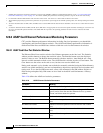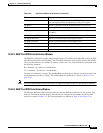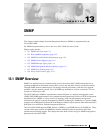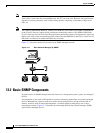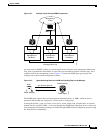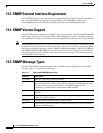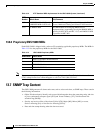
CHAPTER
13-1
Cisco ONS 15600 Reference Manual, R7.2
13
SNMP
This chapter explains Simple Network Management Protocol (SNMP) as implemented by the
Cisco ONS 15600.
For SNMP setup information, refer to the Cisco ONS 15600 Procedure Guide.
Chapter topics include:
•
13.1 SNMP Overview, page 13-1
•
13.2 Basic SNMP Components, page 13-2
•
13.3 SNMP External Interface Requirement, page 13-4
•
13.4 SNMP Version Support, page 13-4
•
13.5 SNMP Message Types, page 13-4
•
13.6 SNMP Management Information Bases, page 13-5
•
13.7 SNMP Trap Content, page 13-6
•
13.8 Proxy Over Firewalls, page 13-11
13.1 SNMP Overview
SNMP is an application-layer communication protocol that allows ONS 15600 network devices to
exchange management information among these systems and with other devices outside the network.
Through SNMP, network administrators can manage network performance, find and solve network
problems, and plan network growth. Up to 10 SNMP trap destinations and five concurrent CTC user
sessions are allowed per node.
The ONS 15600 uses SNMP for asynchronous event notification to a network management system
(NMS). ONS SNMP implementation uses standard Internet Engineering Task Force (IETF) management
information bases (MIBs) to convey node-level inventory, fault, and performance management
information for generic read-only management of SONET technologies. SNMP allows a generic SNMP
manager such as HP OpenView Network Node Manager (NNM) or Open Systems Interconnection (OSI)
NetExpert to be utilized for limited management functions.
The Cisco ONS 15600 supports SNMP Version 1 (SNMPv1) and SNMP Version 2c (SNMPv2c). These
versions share many features, but SNMPv2c includes additional protocol operations and 64-bit
performance monitoring support. This chapter describes both versions and gives SNMP configuration
parameters for the ONS 15600.




